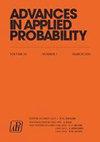Interlacement limit of a stopped random walk trace on a torus
IF 1.2
4区 数学
Q3 STATISTICS & PROBABILITY
引用次数: 0
Abstract
环面上停止随机游走轨迹的交错极限
我们考虑在$\mathbb{Z}^d$上进行一个简单的随机漫步,从原点开始,并在从$({-}L,L)^d \cap \mathbb{Z}^d$的第一个退出时间停止。把L写成$L = m N$的形式,其中$m = m(N)$ N是一个趋于无穷的整数,这样$L^2 \sim A N^d$对于某个实常数$A \gt 0$。我们的主要结果是,对于$d \ge 3$,停止轨迹到n环面的投影局部收敛,远离原点,到水平$A d \sigma_1$的交错过程,其中$\sigma_1$是独立于交错过程的单位立方体$({-}1,1)^d$的布朗运动的退出时间。上述问题是对Windisch(2008)和Sznitman(2009)的结果的变异。
本文章由计算机程序翻译,如有差异,请以英文原文为准。
求助全文
约1分钟内获得全文
求助全文
来源期刊

Advances in Applied Probability
数学-统计学与概率论
CiteScore
2.00
自引率
0.00%
发文量
64
审稿时长
6-12 weeks
期刊介绍:
The Advances in Applied Probability has been published by the Applied Probability Trust for over four decades, and is a companion publication to the Journal of Applied Probability. It contains mathematical and scientific papers of interest to applied probabilists, with emphasis on applications in a broad spectrum of disciplines, including the biosciences, operations research, telecommunications, computer science, engineering, epidemiology, financial mathematics, the physical and social sciences, and any field where stochastic modeling is used.
A submission to Applied Probability represents a submission that may, at the Editor-in-Chief’s discretion, appear in either the Journal of Applied Probability or the Advances in Applied Probability. Typically, shorter papers appear in the Journal, with longer contributions appearing in the Advances.
 求助内容:
求助内容: 应助结果提醒方式:
应助结果提醒方式:


